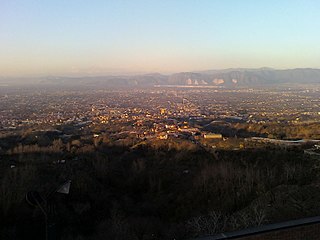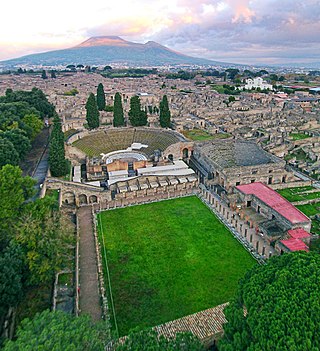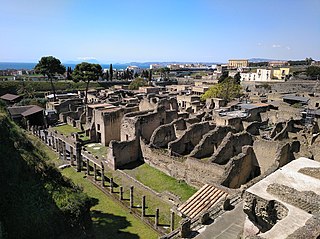
Mount Vesuvius is a somma-stratovolcano located on the Gulf of Naples in Campania, Italy, about 9 km (5.6 mi) east of Naples and a short distance from the shore. It is one of several volcanoes forming the Campanian volcanic arc. Vesuvius consists of a large cone partially encircled by the steep rim of a summit caldera, resulting from the collapse of an earlier, much higher structure.

Nevado del Ruiz, also known as La Mesa de Herveo is a volcano on the border of the departments of Caldas and Tolima in Colombia, about 129 km (80 mi) west of the capital city Bogotá. It is a stratovolcano composed of many layers of lava alternating with hardened volcanic ash and other pyroclastic rocks. Volcanic activity at Nevado del Ruiz began about two million years ago, during the Early Pleistocene or Late Pliocene, with three major eruptive periods. The current volcanic cone formed during the present eruptive period, which began 150,000 years ago.
The Apennine culture is a technology complex in central and southern Italy from the Italian Middle Bronze Age. In the mid-20th century the Apennine was divided into Proto-, Early, Middle and Late sub- phases, but now archaeologists prefer to consider as "Apennine" only the ornamental pottery style of the later phase of Middle Bronze Age (BM3). This phase is preceded by the Grotta Nuova facies and by the Protoapennine B facies and succeeded by the Subapennine facies of 13th-century. Apennine pottery is a burnished ware incised with spirals, meanders and geometrical zones, filled with dots or transverse dashes. It has been found on Ischia island in association with LHII and LHIII pottery and on Lipari in association with LHIIIA pottery, which associations date it to the Late Bronze Age as it is defined in Greece and the Aegean.

The archaeology of Israel is the study of the archaeology of the present-day Israel, stretching from prehistory through three millennia of documented history. The ancient Land of Israel was a geographical bridge between the political and cultural centers of Mesopotamia and Egypt.

Jiahu was the site of a Neolithic settlement based in the central plain of ancient China, near the Yellow River. It is located between the floodplains of the Ni River to the north, and the Sha River to the south, 22 km (14 mi) north of the modern city of Wuyang, Henan Province. Most archaeologists consider the site to be one of the earliest examples of the Peiligang culture. Settled around 7000 BC, the site was later flooded and abandoned around 5700 BC. The settlement was surrounded by a moat and covered a relatively large area of 55,000 square meters. At one time, it was "a complex, highly organized Chinese Neolithic society", home to at least 250 people and perhaps as many as 800.

Joya de Cerén is an archaeological site in La Libertad Department, El Salvador, featuring a pre-Columbian Maya farming village. The ancient Maya site of Joya de Cerén is located in the Zapotitán Valley, 36 kilometers northwest of San Salvador, El Salvador. It is often referred to as the "Pompeii of the Americas", in comparison to the famed Ancient Roman ruins.

Cuicuilco is an important archaeological site located on the southern shore of Lake Texcoco in the southeastern Valley of Mexico, in what is today the borough of Tlalpan in Mexico City.

Omayra Sánchez Garzón was a Colombian girl trapped and killed by a landslide when she was 13 years old.

Somma Vesuviana is a town and comune in the Metropolitan City of Naples, Campania, southern Italy.

The Avellino eruption of Mount Vesuvius occurred in c. 1995 BC. It is estimated to have had a VEI of 6, making it larger and more catastrophic than Vesuvius's more famous and well-documented 79 AD eruption. It is the source of the Avellino pumice deposits extensively found in the comune of Avellino in Campania.

Akrotiri is the site of a Cycladic Bronze Age settlement on the volcanic Greek island of Santorini (Thera). The name comes from the nearby village of Akrotiri.

Prehistoric Orkney refers only to the prehistory of the Orkney archipelago of Scotland that begins with human occupation. Although some records referring to Orkney survive that were written during the Roman invasions of Scotland, “prehistory” in northern Scotland is defined as lasting until the start of Scotland's Early Historic Period.

Pompeii was an ancient city located in what is now the comune of Pompei near Naples in the Campania region of Italy. Pompeii, along with Herculaneum and many villas in the surrounding area, was buried under 4 to 6 m of volcanic ash and pumice in the eruption of Mount Vesuvius in 79 AD.

Oplontis is an ancient Roman archaeological site located in the town of Torre Annunziata, south of Naples in the Campania region of southern Italy. The excavated site comprises two Roman villas, the best-known of which is Villa A, the so-called Villa Poppaea.

Stabiae was an ancient city situated near the modern town of Castellammare di Stabia and approximately 4.5 km southwest of Pompeii. Like Pompeii, and being only 16 km (9.9 mi) from Mount Vesuvius, this seaside resort was largely buried by tephra ash in 79 AD eruption of Mount Vesuvius, in this case at a shallower depth of up to 5 m.

Herculaneum was an ancient Roman town, located in the modern-day comune of Ercolano, Campania, Italy. Herculaneum was buried under volcanic ash and pumice in the Eruption of Mount Vesuvius in 79 AD.

Tas-Silġ is a rounded hilltop on the south-east coast of the island of Malta, overlooking Marsaxlokk Bay, and close to the town of Żejtun. Tas-Silġ is a major multi-period sanctuary site with archaeological remains covering four thousand years, from the neolithic to the ninth century AD. The site includes a megalithic temple complex dating from the early third millennium BC, to a Phoenician and Punic sanctuary dedicated to the goddess Astarte. During the Roman era, the site became an international religious complex dedicated to the goddess Juno, helped by its location along major maritime trading routes, with the site being mentioned by first-century BC orator Cicero.

The Cantabrian caves' unique location make them an ideal place to observe the settlements of early humans thousands of years ago. The magnificent art in the caves includes figures of various animals of the time such as bison, horses, goats, deer, cattle, hands and other paintings. Archaeologists have found remains of animals such as bears, the remains of arrows and other material indicating a human presence; these artifacts are now found mostly in the Regional Museum of Prehistory and Archaeology of Cantabria.

Of the many eruptions of Mount Vesuvius, a major stratovolcano in southern Italy, the best-known is its eruption in 79 AD, which was one of the deadliest.
Aguazuque is a pre-Columbian archaeological site located in the western part of the municipality Soacha, close to the municipalities Mosquera and San Antonio del Tequendama in Cundinamarca, Colombia. It exists of evidences of human settlement of hunter-gatherers and in the ultimate phase primitive farmers. The site is situated on the Bogotá savanna, the relatively flat highland of the Altiplano Cundiboyacense close to the present-day course of the Bogotá River at an altitude of 2,600 metres (8,500 ft) above sea level. Aguazuque is just north of another Andean preceramic archaeological site; the rock shelter Tequendama and a few kilometres south of Lake Herrera. The artefacts found mostly belong to the preceramic period, and have been dated to 5025 to 2725 BP. Thus, the younger finds also pertain to the later ceramic Herrera Period. There were some difficulties in dating of the uppermost layer due to modern agricultural activity in the area; the sediments of the shallower parts were disturbed.


















